1lumen selects and reviews products personally. We may earn affiliate commissions through our links, which help support our testing.
Fenix TK20R UE review
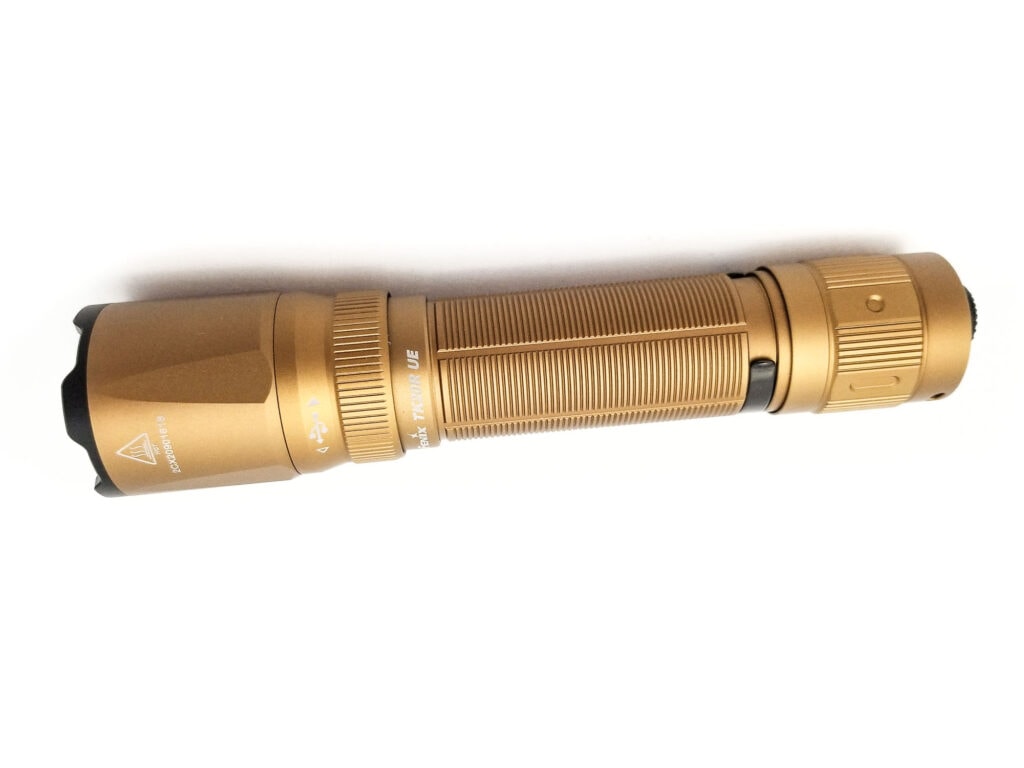
Fenix TK20R UE specs
| Brand & Model | Fenix TK20R UE |
|---|---|
| Flashlight category | Tactical, Duty, and General Purpose |
| LED | Luminus SFT70 |
| Max. output | 2800 lm |
| Max. beam distance | 465 m |
| Max. beam intensity | 52,880 cd |
| Battery config. | 1*21700 |
| Onboard charging | USB type C |
| Main modes | 4 |
| Blinkies | Strobe |
| Waterproof | IP68 |
| Review publication date | August 2023 |
Review intro:
Another Fenix light on deck! Fenix needs no introduction, not just because 1Lumen has done a number of Fenix flashlight reviews, but because they make great flashlights for just about any task that appeal to all sorts of folks. I’ve reviewed a bunch of Fenix lights to date, and can attest to their high quality and good performance. There’s a deep product catalog to sample as well, from affordable EDC pieces, keychain lights, to professional-grade search and rescue lights, tactical, duty, general purpose, and utility lights.
On deck for today is the latest version of their TK20 tactical, duty, or general purpose flashlight. I reviewed the newest TK20R, the v2, two years ago, and really liked its fully protected charge port and very good output (even if it didn’t meet the Turbo spec). Well, now there’s a new version of the TK20R. V3? Nope, UE. I’m not sure what the UE means (perhaps Ultimate Edition), but Fenix gave it some fancy paint jobs (no, really, not just black) and an equally fancy switching system. Read on for more!
Package quality.
Like other Fenix lights, the TK20R UE comes in an unassuming, utilitarian package. It’s a tidy package and perfect for retail on the hang tag rack. Inside, the flashlight rides in a molded carrier, and the accessories are stored underneath. It’s nice to see the hinged bottom again since the accessories tend to spill out once you pull out the carrier. Here’s what’s inside:
- Fenix TK20R UE flashlight
- Fenix ARB-L21-5000 21700 battery
- Holster
- Lanyard
- 2 spare o-rings
- Manual
- USB type C cable
- Warranty card
- Promotional documentation
Once again, this is a super comprehensive kit with everything needed for ready-to-run. Open the box, pull out the light, unscrew the tailcap and remove the isolator, and you’re ready to go. The only thing not optimized is the battery, which was deeply discharged (for storage) to 3.6 volts, so you’ll need to charge that.
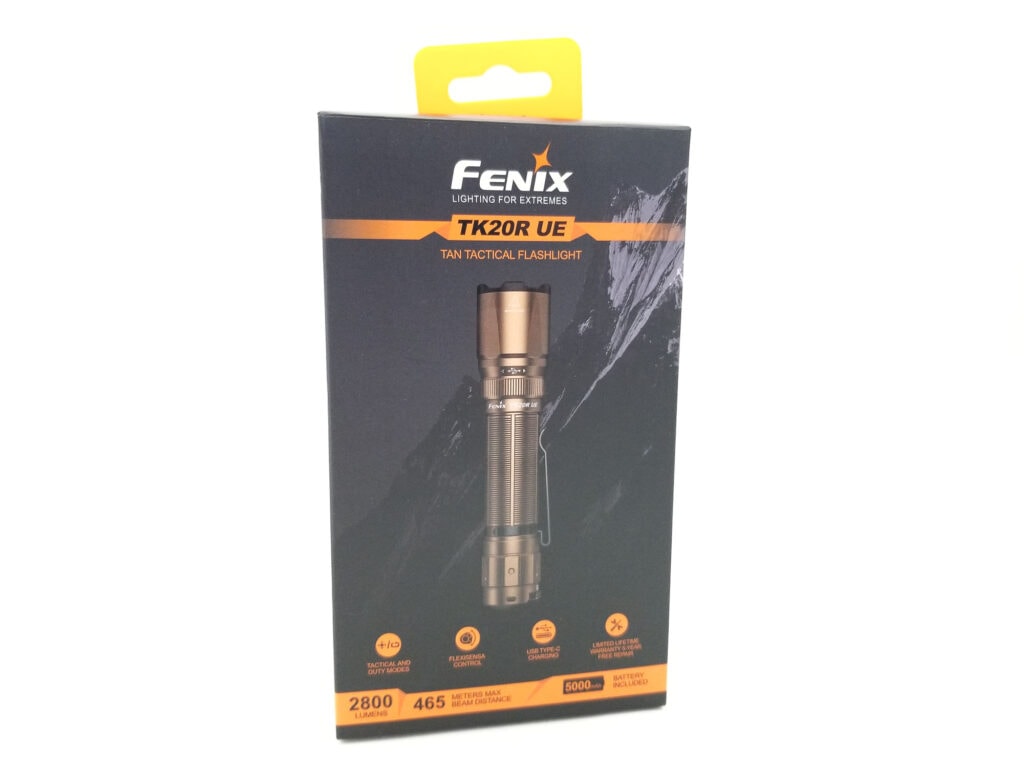
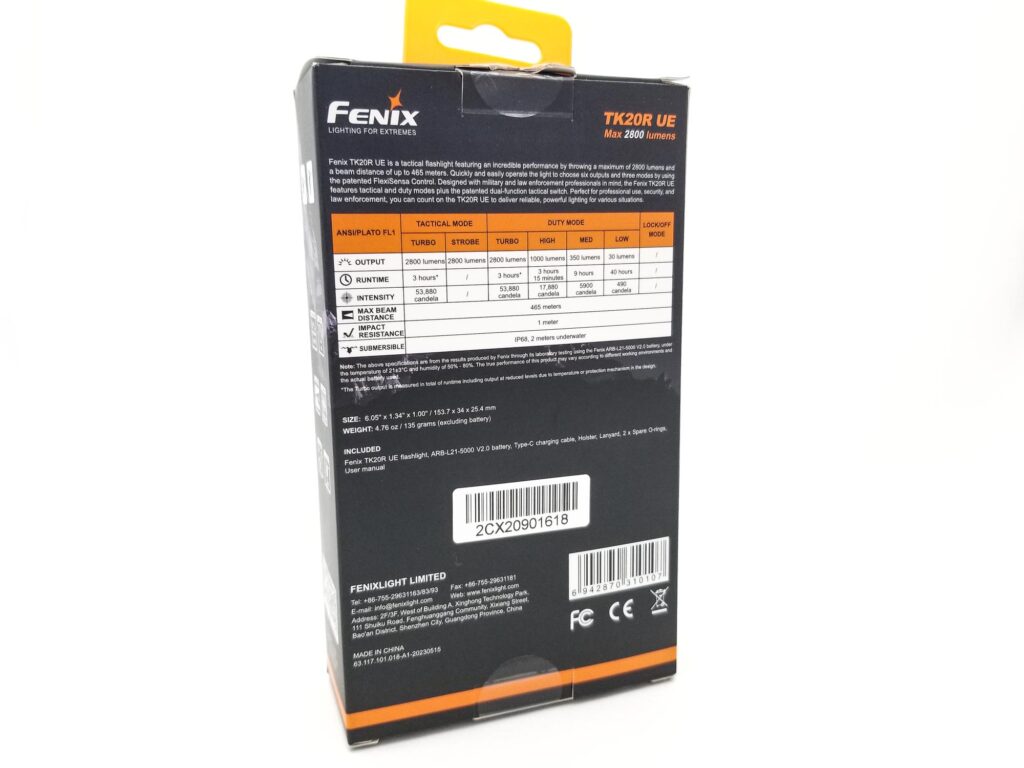
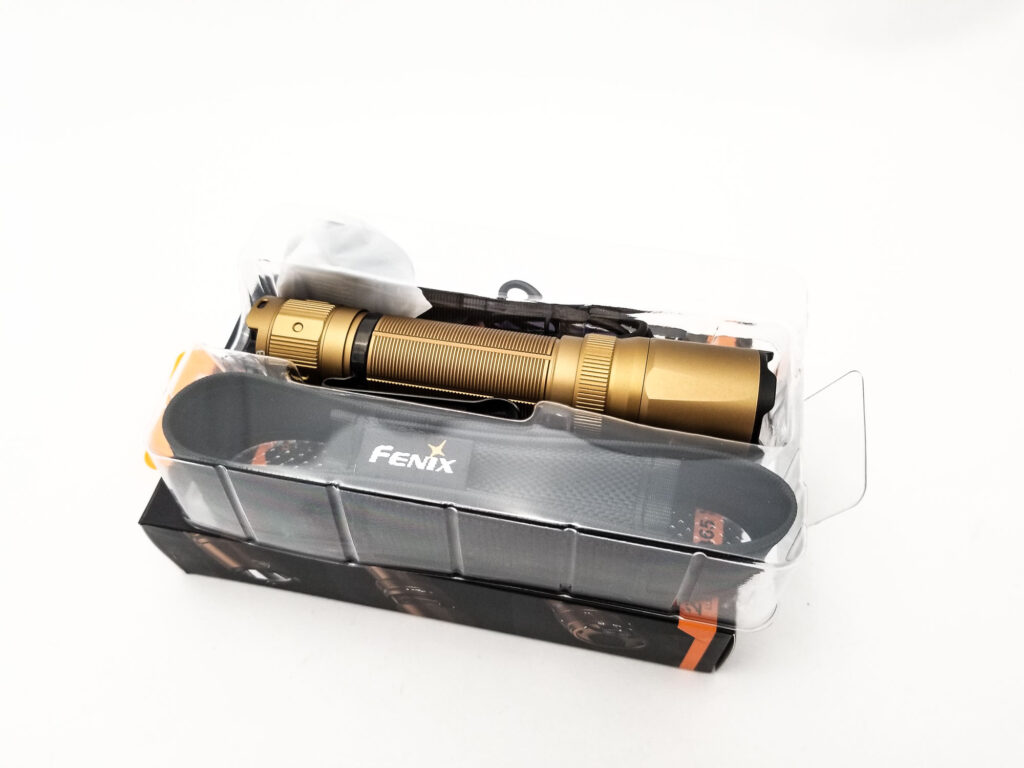
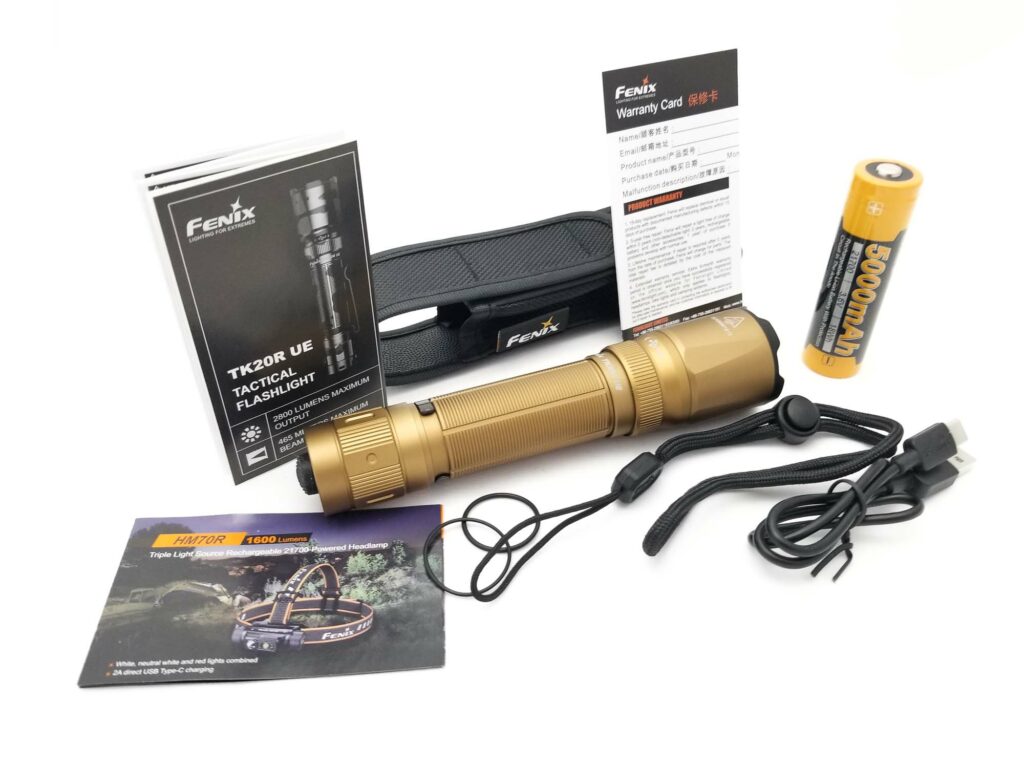
Flashlight in use
The Fenix TK20R UE is a dual-role tactical-use and general purpose flashlight, and would be equally happy riding on the end of a long gun, a duty belt, work belt, battle rattle, MOLLE gear, or in a tool box. First responders, security, law enforcement, S&R, and other professionals would be the primary users, but it would be an excellent general purpose light as well.
The 1-inch diameter battery tube feels excellent in the hand and it would fit just about any hand size perfectly, from meat mitts to Hobbit hands, with or without gloves. The whole thing weighs a hair over 200 grams loaded, so it’s properly lightweight to minimize hand fatigue during prolonged operation, and cuts ounces off a duty belt, which might also carry a firearm, holster, ammo pouches, magazines, handcuffs, radio, Taser, baton, and other gear, so every gram counts! It’s nicely balanced, and points naturally in over and underhand grips. It’s less suited for a cigar type grip though. The battery tube features grippy reeding, and vertical micro grooves on the charge port cover made twisting the cover open and closed very easy. I think Fenix may have tweaked that a bit, since the port cover seemed to need fewer rotations to retract.
The regular TK20R v2 featured a dual switch arrangement with a smaller momentary switch for mode switching and a large forward clicky for on-off/momentary use. The new UE model has a totally revised switching layout. The forward clicky is still present, but the momentary button has been eschewed in favor of a selector switch (more on that in the UI section). Fenix is no stranger to these switches. The Fenix PR36R Tac and TK22 Tac use one, and the PD40R also uses one (albeit in a different capacity). The selector switch controls the UI’s lighting mode selection, while the forward switch controls the on/off and mode switching.
The mechanical switch has a great feel, with solid, snappy clicks and great feedback. It also sticks out quite a bit, which makes manipulation easy when wearing gloves. The selector has a tang that sticks out and makes it easy to manipulate one-handed with a finger or thumb, and it’s tactile enough to be used with gloves on. The selector is nicely detented as well, and wouldn’t be bumped out of position easily. Both switches are weighted very nicely with the right amount of resistance to clicks to avoid accidental activation. I had no trouble manipulating both switches with my thumb in the overhand grip.
The TK20R UE is compact enough to fit in a jacket pocket, and thanks to the strong pocket clip and lanyard mounting points (clip, and two in the tailcap), along with the holster, there’s lots of retention options. The pocket clip can be removed, and Fenix offers a ton of accessories for mounting to a weapon (M-LOK rail mount, clamp-type barrel mounts and a remote switch) and accessories for duty use like a traffic cone, diffuser, red filter, quick-release duty holster, and belt clip. The tailcap has two lanyard mounting points, and they’re nicely sized so folks with fingers larger than Tinkerbell can thread the lanyard easily.

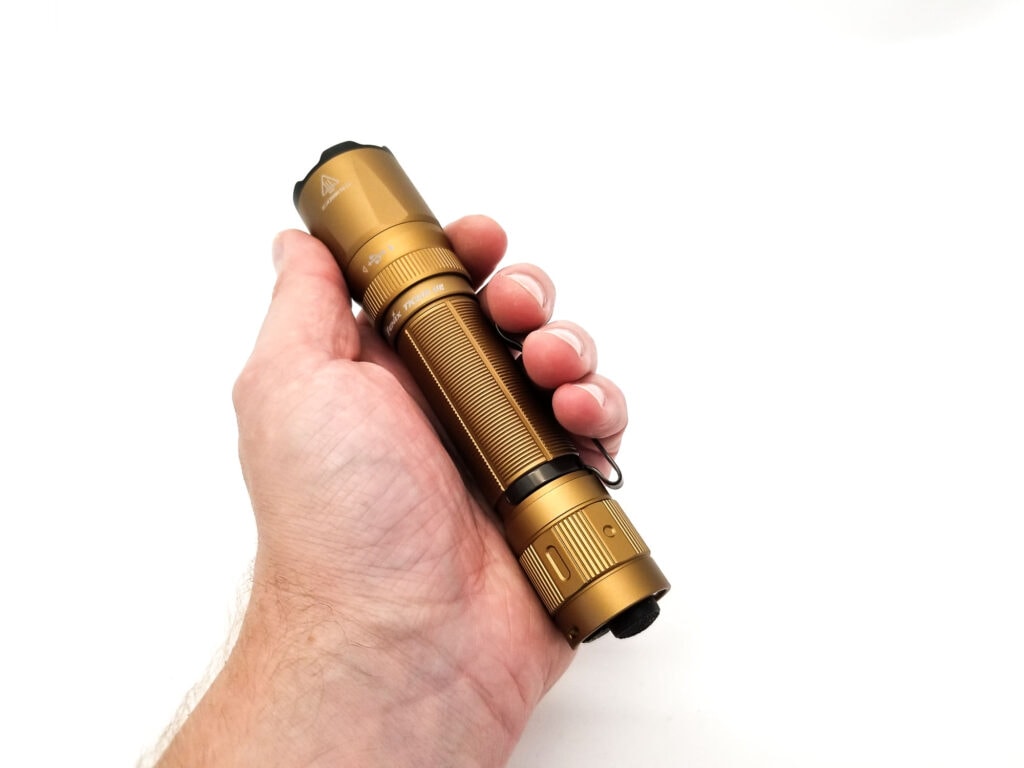
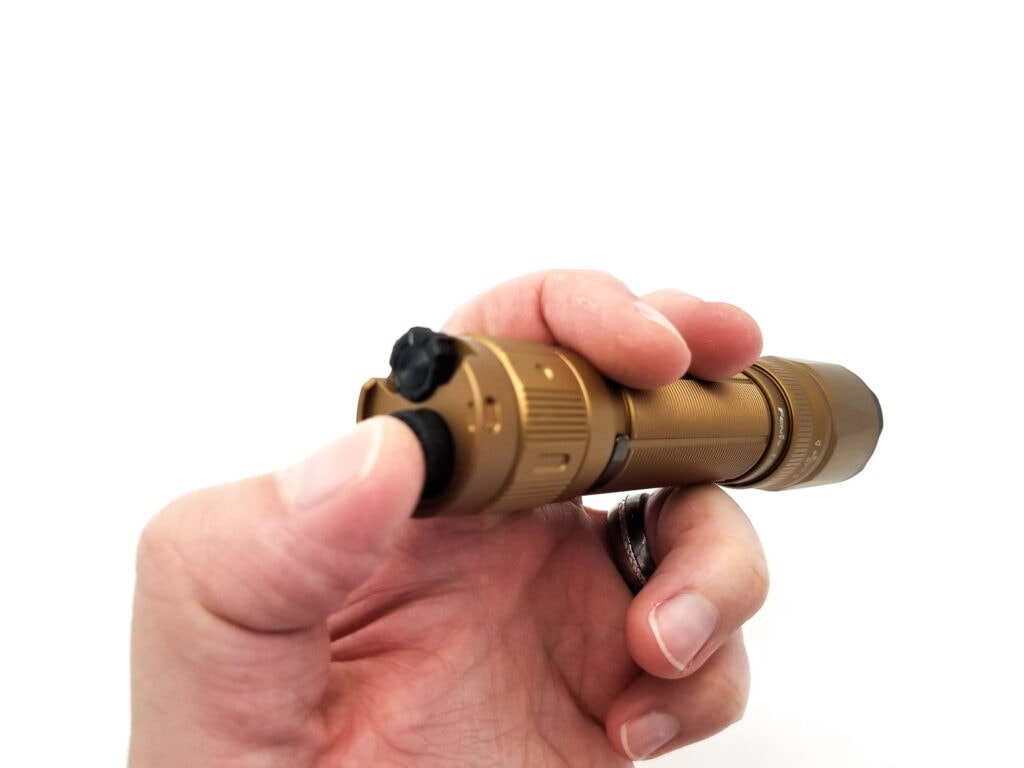
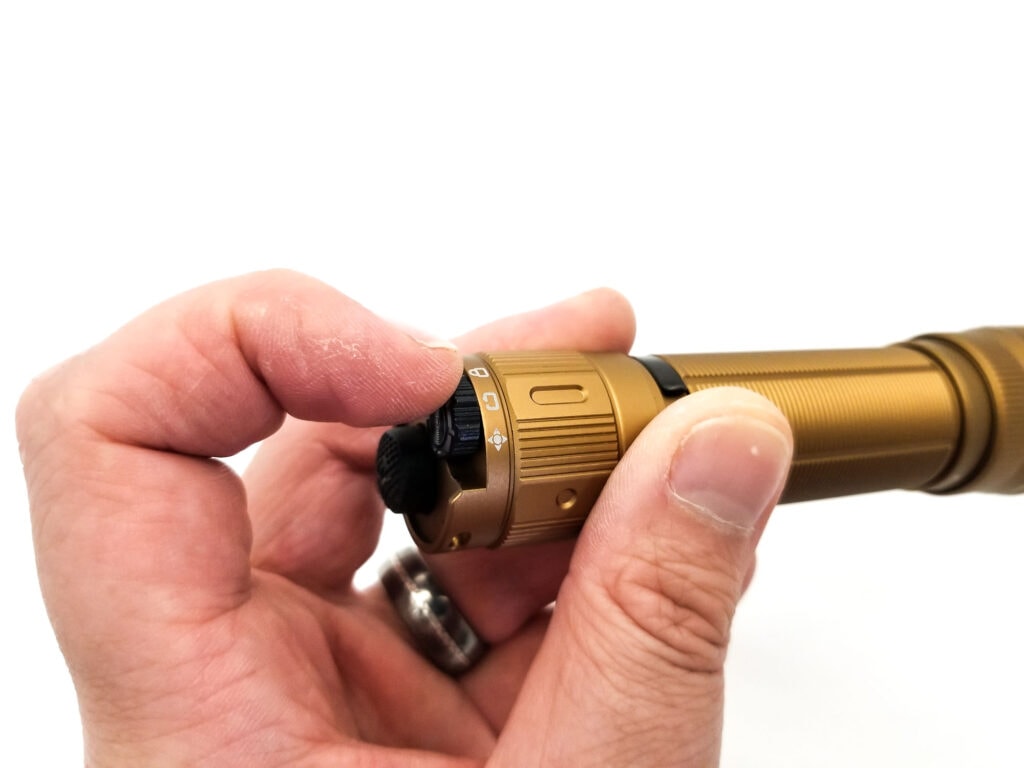
Build Quality and Warranty
Fenix lights are very high quality items and the TK20R UE carries this forward. You pay for quality here though, and it’s not a budget light coming in around $140 US. Although a bit steep, it’s not an unreasonable price for a professional-grade tool that will be reliable and last a long time. Olight, Acebeam, Nitecore all have lights at similar prices, so the price is competitive.
The light is milled from 6061-T6 aluminum, and the machining is super-tidy, and every edge has been knocked down and smoothed. In care you’re wondering, smooth edges make it easier when drawing or re holstering the flashlight since there’s no abrupt edges to catch on things. The engraving and silk screen text is super sharp as well, and all the parts fit together perfectly, including the retractable charging port cover, which unscrews super-smoothly with no wobbles or play whatsoever. Even the battery fits in the tube perfectly: It’s loose enough to easily extract, but does not rattle around at all. The finish is a semi-gloss type III HA anodizing, and it comes in four flavors: A copper camo, tropical green, metallic tan, and city gray. Mine came in the metallic tan and it’s beautiful! The finish is very high quality and seems durable. All my Fenix lights have held up very well.
The only removable part is the tailcap, which has fully anodized (for mechanical lockout), large, and very precisely machined rectangular threads. They’re very generously lubed and super-duper smooth. The threads for the retractable charge port cover are triangular cut and sturdy enough, and buttery smooth. For springs, there’s two at work here. The driver and tail spring are thick gold-plated units, and that’s important in a tactical or professional-use light since they act like shock absorbers. It’s also mission-critical for weapon-mounted duty wherein the springs absorb recoil energy that can be transferred to the driver and cause damage or connection breaks from the battery rebounding off the driver contact. Unlike other lights with dual switches, there’s no signal tube, thanks to both switches being mounted on the tailcap. Although there’s nothing wrong with the signal tube design, it eliminates a potential failure point and makes for a more robust design. It’s rated for a proper IP68 water resistance, even with the charge port uncovered, good for up to 1 meter immersion of up to 30 minutes. Very impressive and great attention to detail!
Warranty? Fenix Lighting US, guarantees all Fenix products purchased from retailers to be made of first-class materials and therefore provides a lifetime warranty against any defects in material and workmanship. Excluded from warranty coverage is any damage to the exterior deemed reasonable wear and tear such as scratches and/or fading of color. In addition, the warranty does not apply to damage caused by abnormal or unreasonable use of any of the components. This includes use of unapproved batteries in Fenix products.
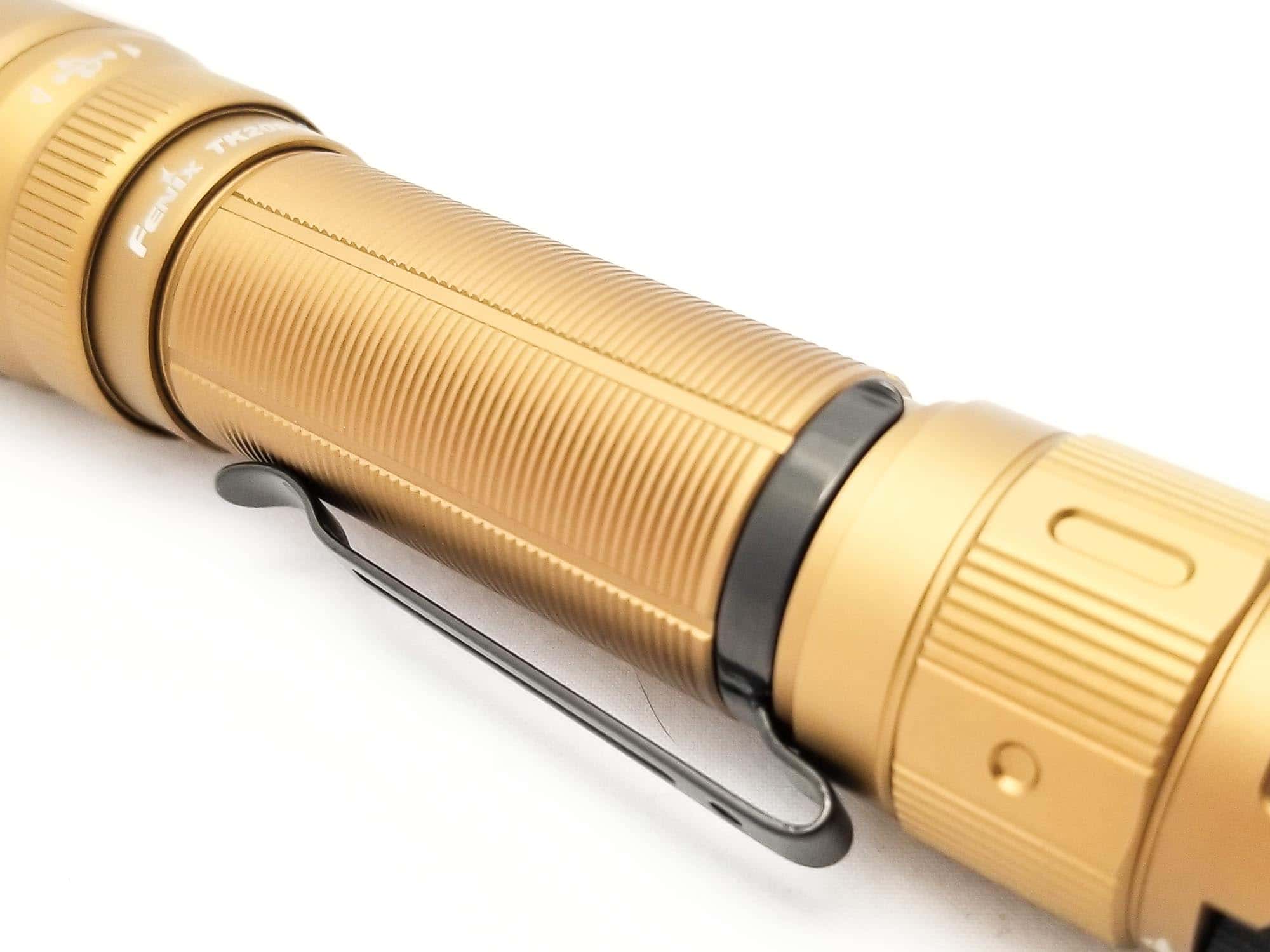
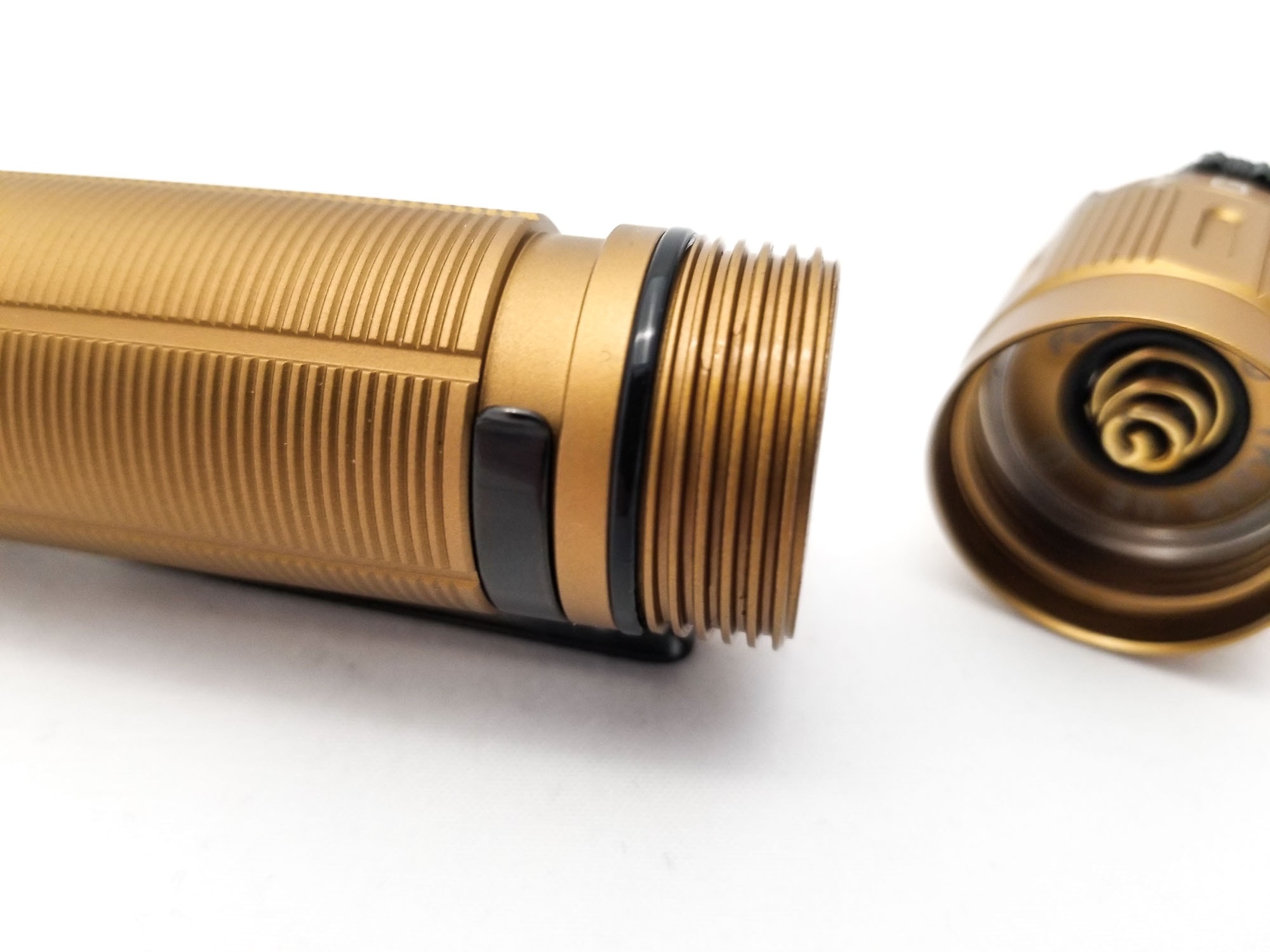

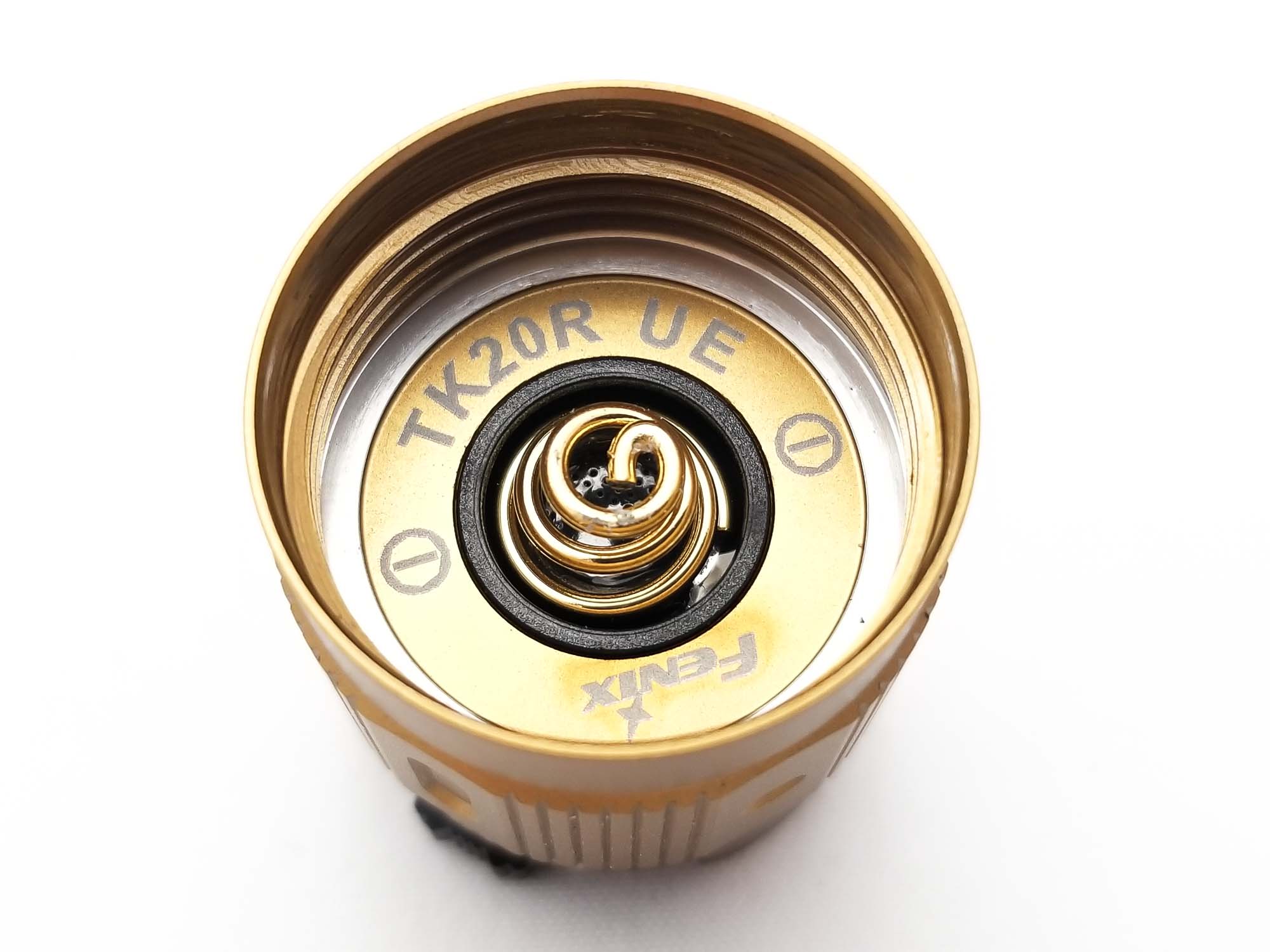
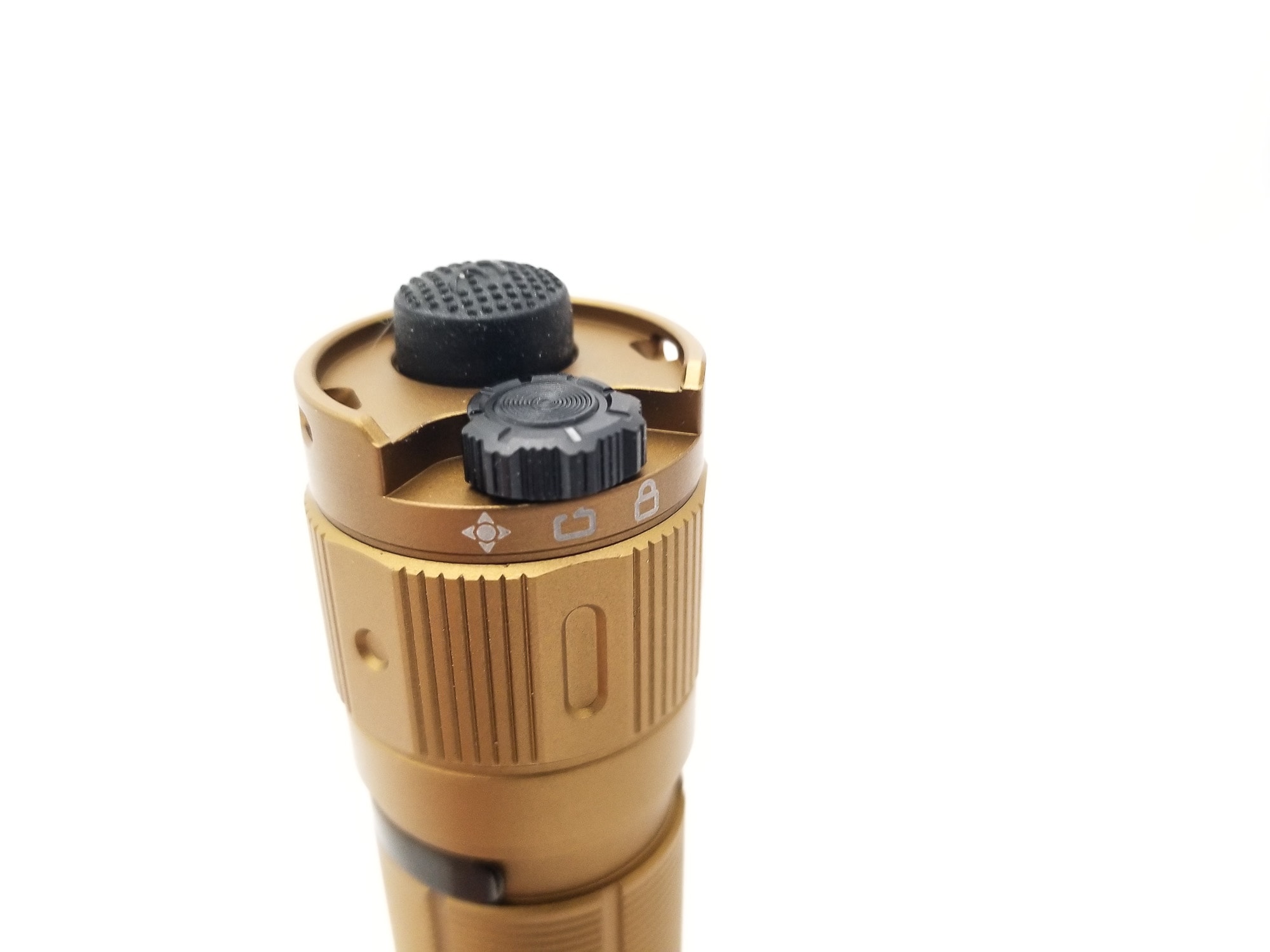
LED, Lens, Bezel, Beam, and Reflector
The TK20R v2 and TK20R UE feature the same LED. This LED represents the latest and greatest from Luminus, the SFT70. This is a quad die domeless LED that I’ve seen in a bunch of other lights so far in 2022 and 2023, including Olight, Thrunite, Cyansky, and Fenix. This is an extremely versatile LED. it’s a 5050 (5mm x 5mm) footprint and it runs on 6 or 12 volts. The bond wires are embedded in the substrate and this helps current handling and heat dissipation at higher drive currents, and this can be safely driven to 6 amps for around 3200 Lumens if properly cooled. The LES is about 6.4mm2, so a tad bigger than an XHP35 HI at around 5.3 mm2. No tint is specified, but it’s going to be cool white, and like every other CW Luminus product, it’s a bit green at lower drive currents and the Opple Lightmaster Pro agrees.
The Turbo setting comes in at 6579K and CRI Ra 68. The duv is 0.0042, so a bit less green than other SST and SFT’s I’ve run.
The bezel is a black PVD coated stainless unit with mild crenulations. The lens is a toughened mineral glass unit with a mild violet AR coating. The lens is nicely recessed and well protected. The beam is geared towards tactical and general purpose use, with a medium size bright hotspot transitioning to lots of bright spill. At close range, the hotspot casts a good size area of blinding light, and farther out the hotspot spreads out quite a bit, but still carries good intensity. The beam is artifact-free and doesn’t have a donut hole.
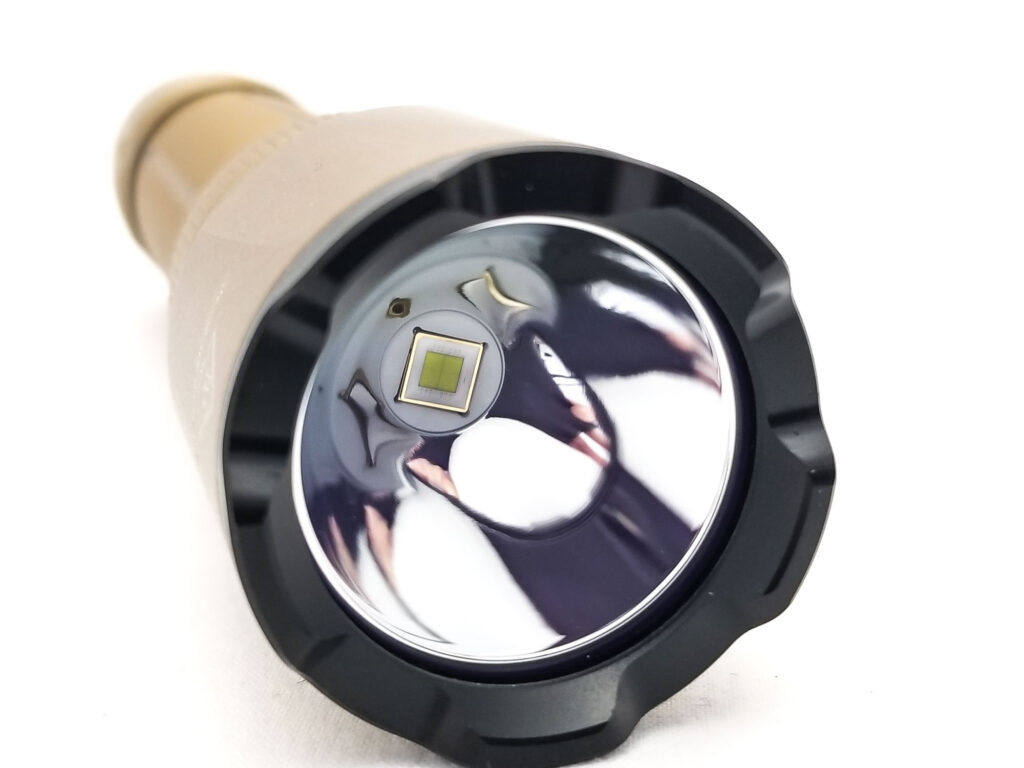
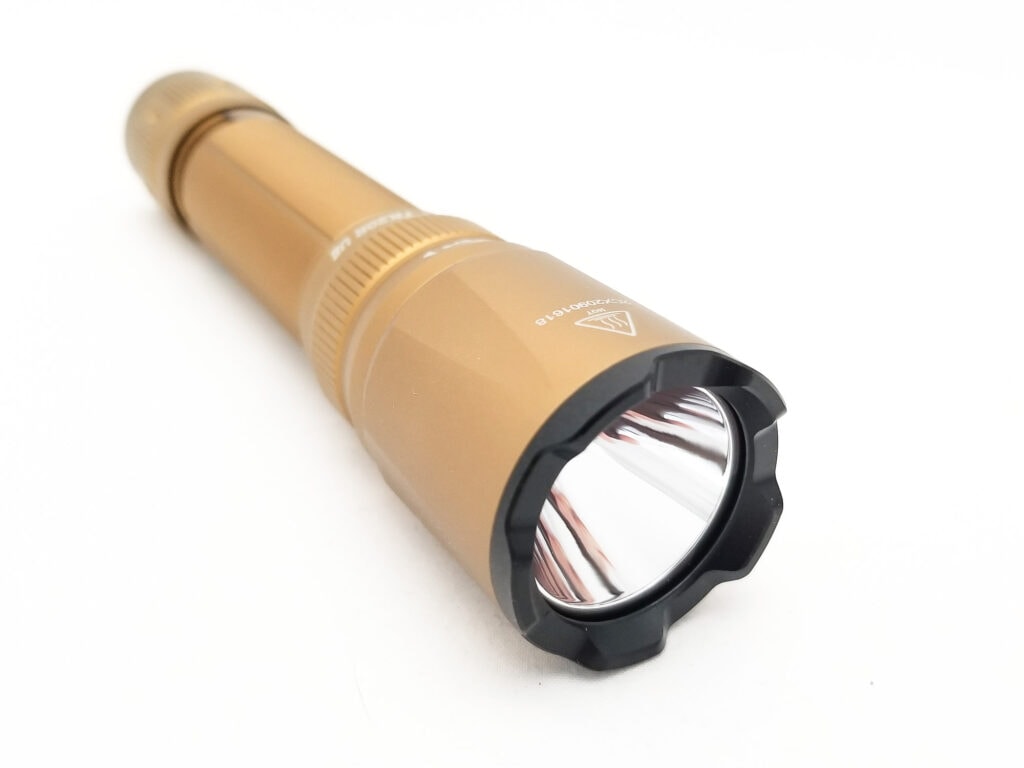
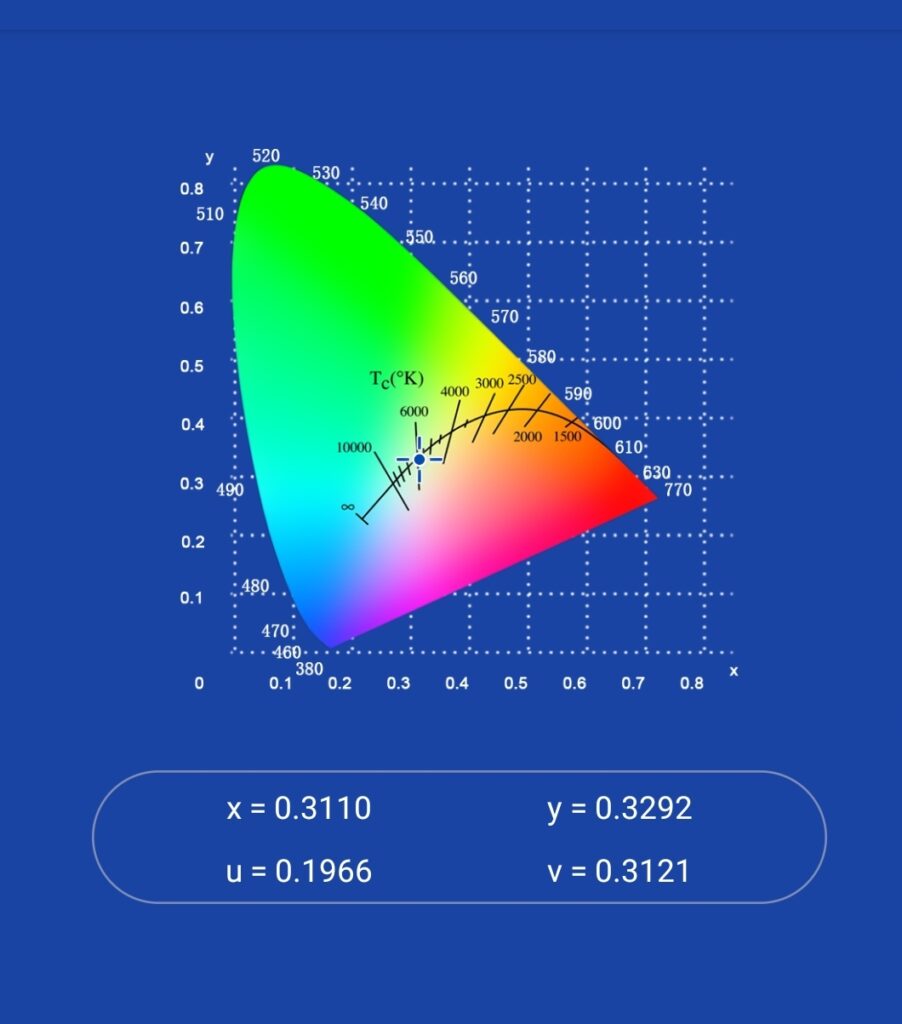
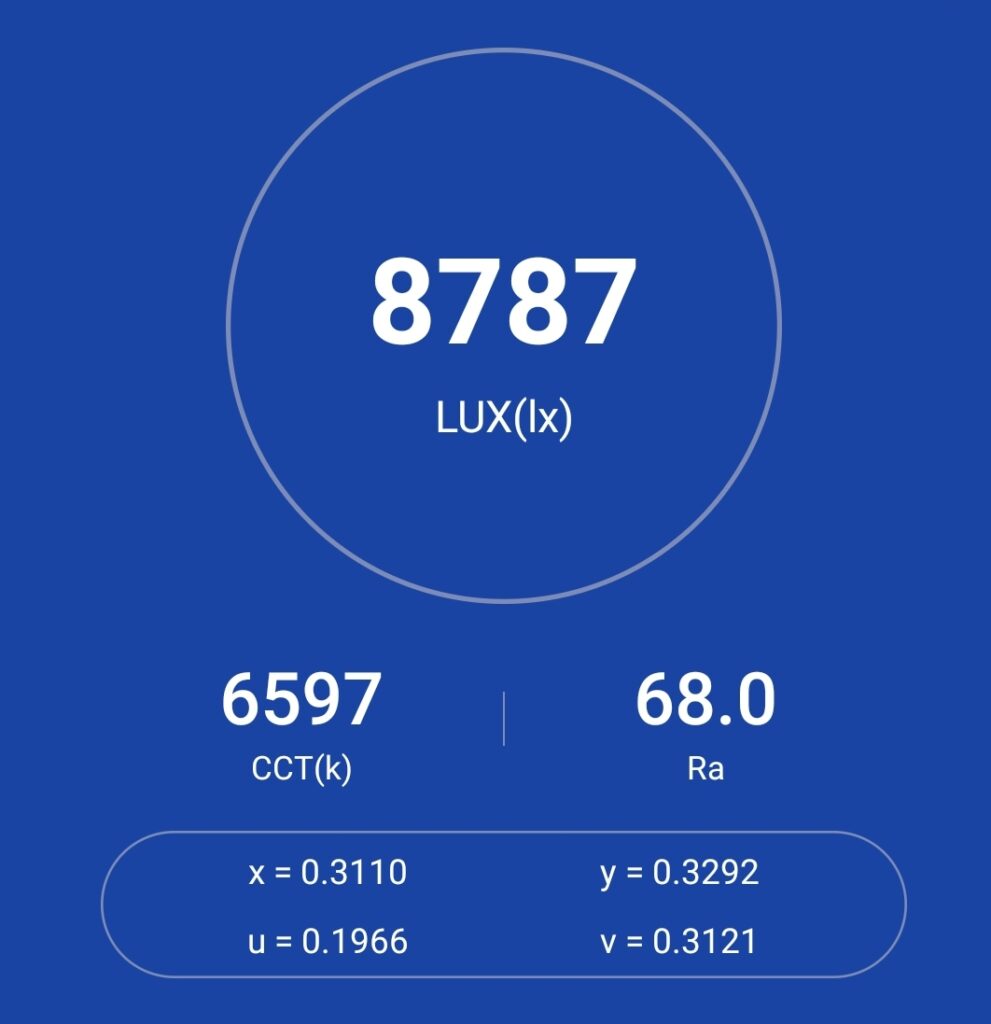
Dimensions and its competition
| Fenix TK20R UE | Millimeters | Inches |
|---|---|---|
| Length | 154 mm | 6 in |
| Head diameter | 34 mm | 1.3 in |
| Body | 25 mm | 1 in |
Dimensions are rounded to the nearest millimeter, and to the nearest tenth of an Inch.
Weight:
| Fenix TK20R UE | Weight in grams | Weight in oz |
|---|---|---|
| With ARB-L21-5000 battery: | 204 g | 7.2 oz |
| Without battery: | 135 g | 4.8 oz |
Weight is rounded to the nearest gram, and to the nearest tenth of an oz. The TK20R UE is pretty lightweight for a full-size 21700 duty light. It’s lighter than the new Nitecore SR7Ti without the battery!
Flashlight size comparison with its competition:
Compared to some tactical style flashlights
Group 1 left to right: Fenix TK20R v2, Thorfire C8, Olight Warrior 3S Ti, Fenix TK20R UE, Fenix PD36 Tac, Acebeam P17 Defender
Group 2 left to right: Fenix TK20R v2, Fenix TK20R UE, Fenix PD40R, Fenix PD36 Tac
Group 3 switches left to right: Fenix PD36 Tac, Fenix TK20R UE
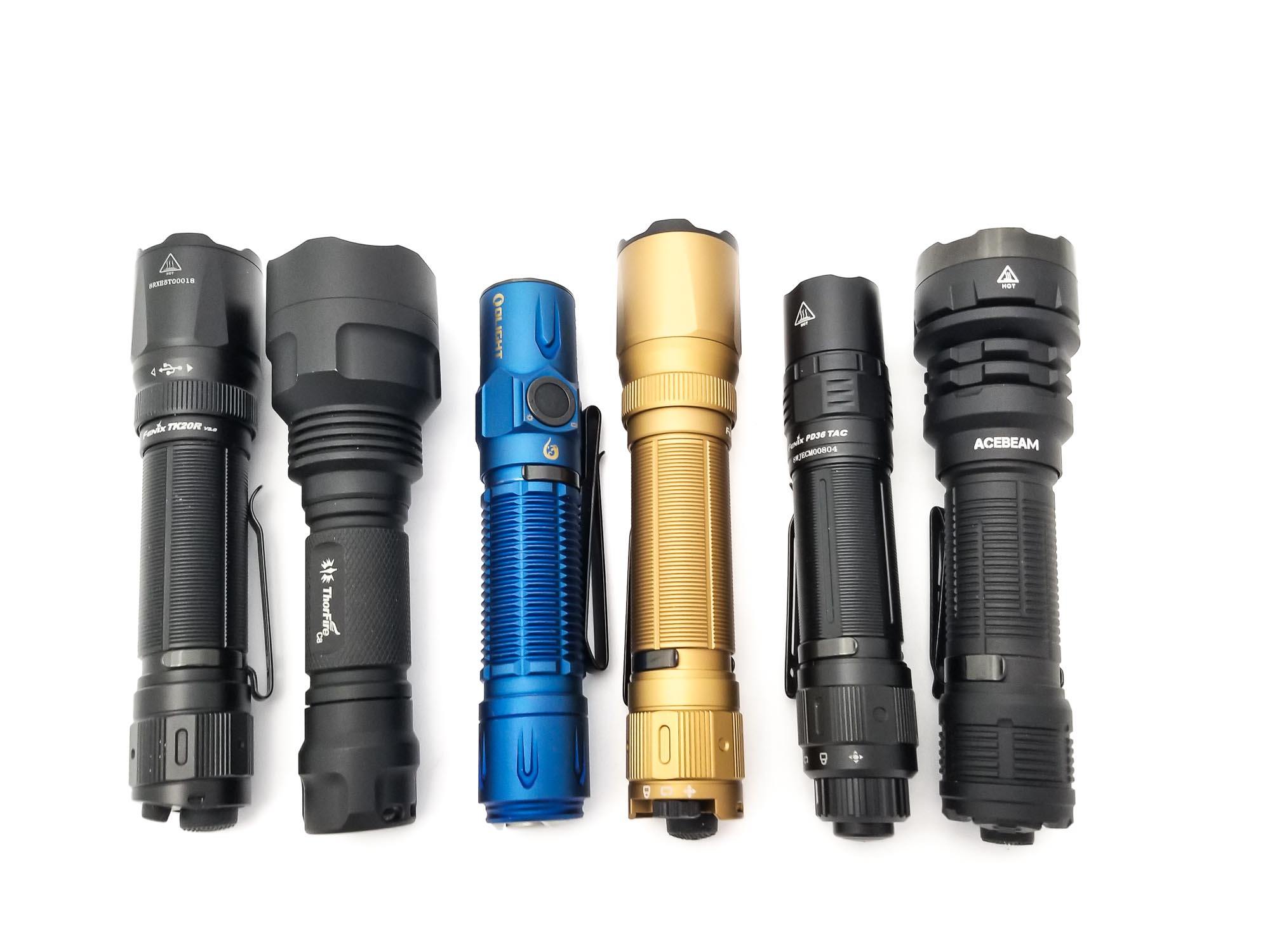
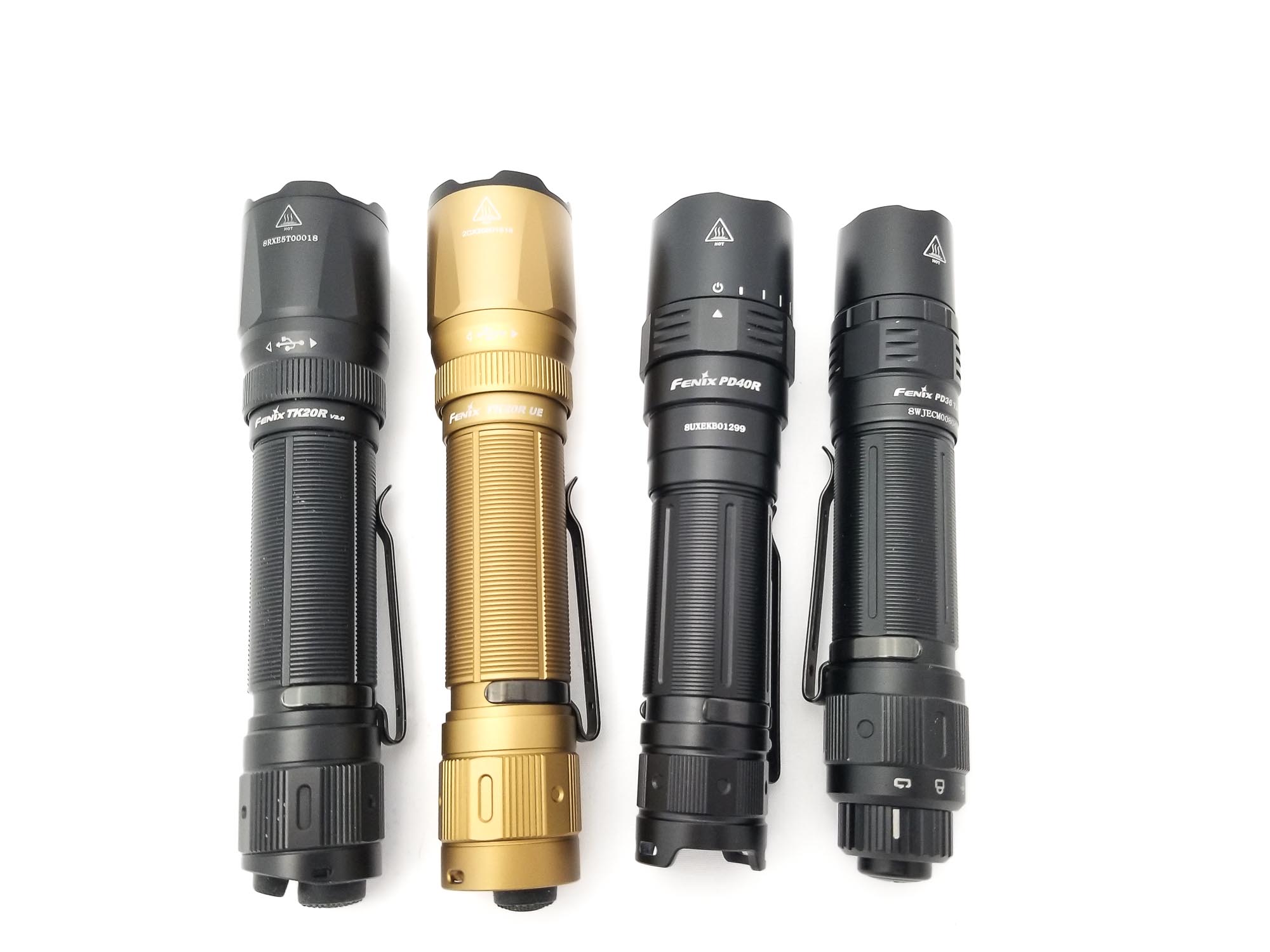
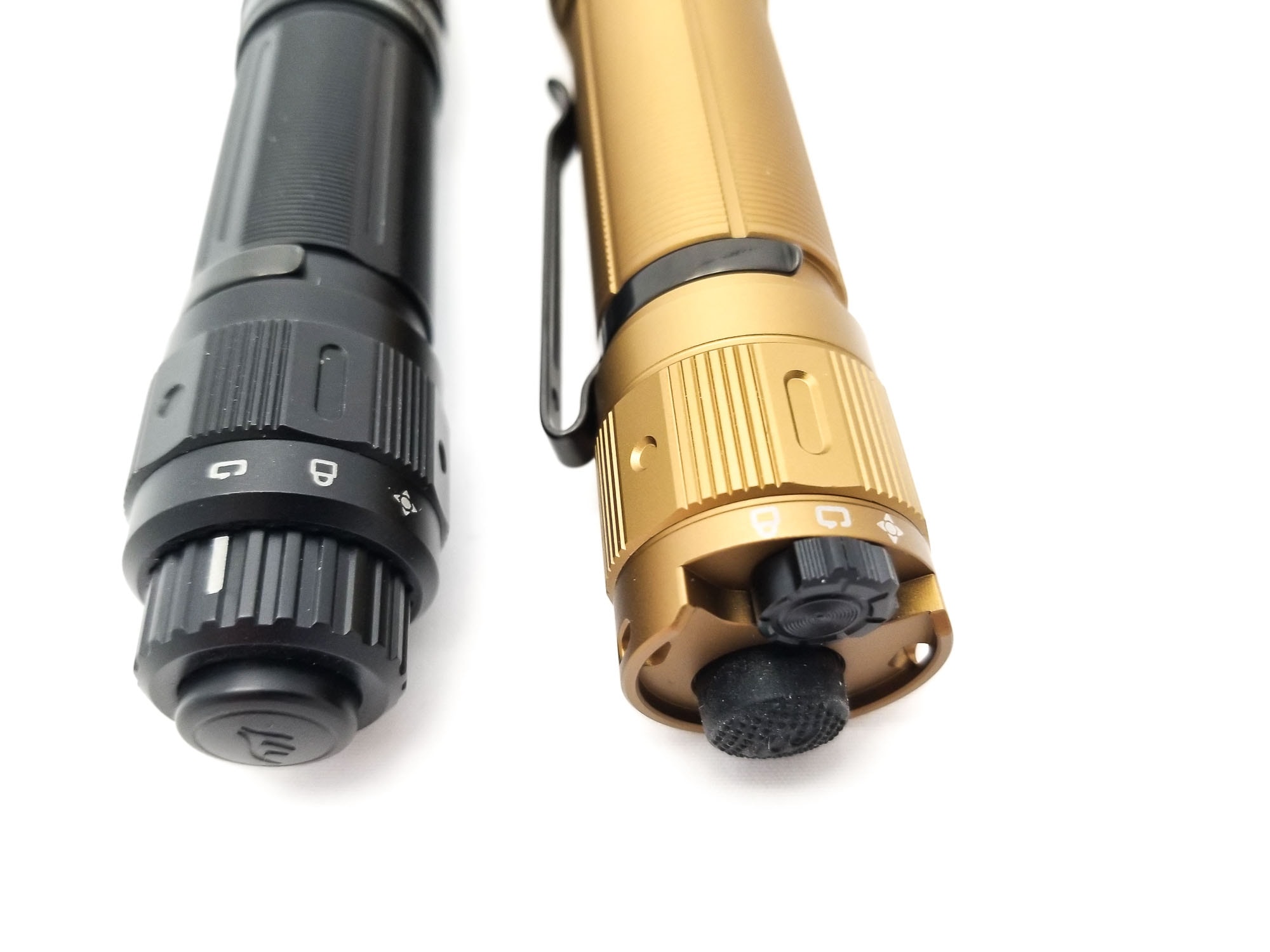
Fenix TK20R UE UI: User Interface and Driver
Like other professional-use lights, the TK20R UE features a constant-current buck driver for consistent brightness. Unlike FET drivers, the output is not affected by the battery voltage, so as the battery drains, the output stays consistent until LVP kicks in. This is obviously important for professional use since it’s no bueno for your light to go dim during a stakeout or search and rescue mission, right?
The UI is typical of Fenix’s other duty and tactical-use lights, but this one is modeled closer to the PD36 Tac light with the selector switch. With the UE, there’s two mode groups available, Tactical and Duty, each with its own modes, selectable with the selector switch, which Fenix calls it the FlexiSensa Control (we’ll call it the selector switch). It has three positions: Duty Mode (the middle position), Tactical Mode (the leftmost position), and Lockout (rightmost position). Duty Mode consists of 4 modes with mode memory,Tactical Mode is Turbo and Strobe. The Lockout position deactivates the light.
Duty Mode:
- Low, Medium, High, Turbo
Tactical Mode:
- Turbo, Strobe
Available blinky modes:
- Strobe (part of Tactical Mode)
From OFF:
- Fully click forward switch: Turns on in last used mode in Duty Mode, Turbo in Tactical Mode
- Tap forward switch: Momentary on for Duty Mode, momentary Turbo in Tactical Mode
From ON:
- Fully click forward switch: Turns off
- Tap forward switch: In Duty Mode switches modes (starting from last used mode). In Tactical Mode, momentary Turbo. When in Turbo in Tactical Mode, tapping the switch activates Strobe. Tapping again reverts to Turbo
Mode memory:
- Remembers last brightness level in Duty Mode. Turbo and Strobe are both memorized (in Tactical Mode)
Shortcuts:
- N/A
Low voltage warning:
- The LED indicator under the charge port cover will show battery state when turned on:
- Solid green for 100-85%
- flashing green for 85-50%
- solid red for 50-25%
- LED flashes red for 25-1% (critical battery level).
Strobe/blinkies
- Strobe
Lock-out mode:
- To lockout the light, move the selector switch to the Lockout position. The light will be totally deactivated
PWM
- None
Additional/summary info on the UI: I think a round of applause is in order here since Fenix has fielded a UI that competes with the best out there from Acebeam, Klarus, and Olight. In fact, the Warrior 3S and Klarus XT11GT Pro V2 are currently my favorite tactical/duty UIs, and this new ‘UE’ from Fenix changes the game a bit. While I’m still spoiled by the Warrior 3S UI (yep, it’s just about perfect), I really like this UI. I thought the selector would be gimmicky and superfluous, but it just works!
This is a pretty foolproof and very intuitive UI that is easy to use, and would be easy to use even under duress, which is critical for a light that’s going out into the field with LE, security, or first responders who need Turbo or Strobe right now. The mode spacing in Duty Mode is very good as well and fits a wide range of lighting needs. The only thing I’d change is that you need to fully click the forward switch to switch modes, and it can be easy to accidentally activate Strobe, and it took a few minutes of practice to remedy the fact that Turbo turns to Strobe really easily. With practice, it’s not an issue, and still makes for a good police flashlight. Low Voltage Warning is a bit wonky since the LED indicator is under the charge port cover and hidden so you can’t see it. I think an external indicator is a much better option here (hint, hint Fenix)
Fenix TK20R UE Charging and batteries
The TK20R UE shares the same 21700-size battery as the TK20R V2. The kit includes Fenix’s excellent Fenix ARB-L21-5000 V2 battery. This is a button-top 5000 mAh 21700 with a protection board. It’s about 75 mm long, so a bit long. Here’s where Fenix gets a big nod from me because they’ve kept the battery compatibility consistent across their 21700-size lights, e.g. you can use just about any of the Fenix-branded 21700s in any 21700 size light, only limited by length. Your button top cells and flat top cells fit here. My button top Epoch 50Gs fit, and so did the Cyansky protected 5000 mAh 21700, and the Acebeam protected 21700 with USB charging.
Fenix doesn’t recommend using non-Fenix batteries, and you risk voiding the warranty for using “unapproved batteries” which also includes CR123 and 18650-size cells. The Fenix battery has built-in LVP, and per the manual it says LVP (at least the LVP features) only works with this battery. I’m not sure if it’s also built into the driver, but I’d think it is since the boost controller IC drops the light out of regulation and switches off if it can’t get 5 volts.
(According to our reviewer Tim, the battery has low voltage protection, but not the flashlight itself).
The TK20R UE has the same charging setup as the TK20R v2, with USB type C input. However, I got a surprise when charging the light after a runtime test. The TK20R topped out at 2.1 amps, but the TK20R UE bumps it to 2.7 amps. On USB type A, I saw 2.7 amps max from the Ruideng AT35 and my type C tester, and this charged the battery in about 3 hours. Charging also worked with USB type C to C charging as well, with no change in the charging current. I did notice some quirks with charging though. The battery generally charged to between 4.14 volts, measured when I pulled the battery after the current dropped very low to 0.03 A on the tester.
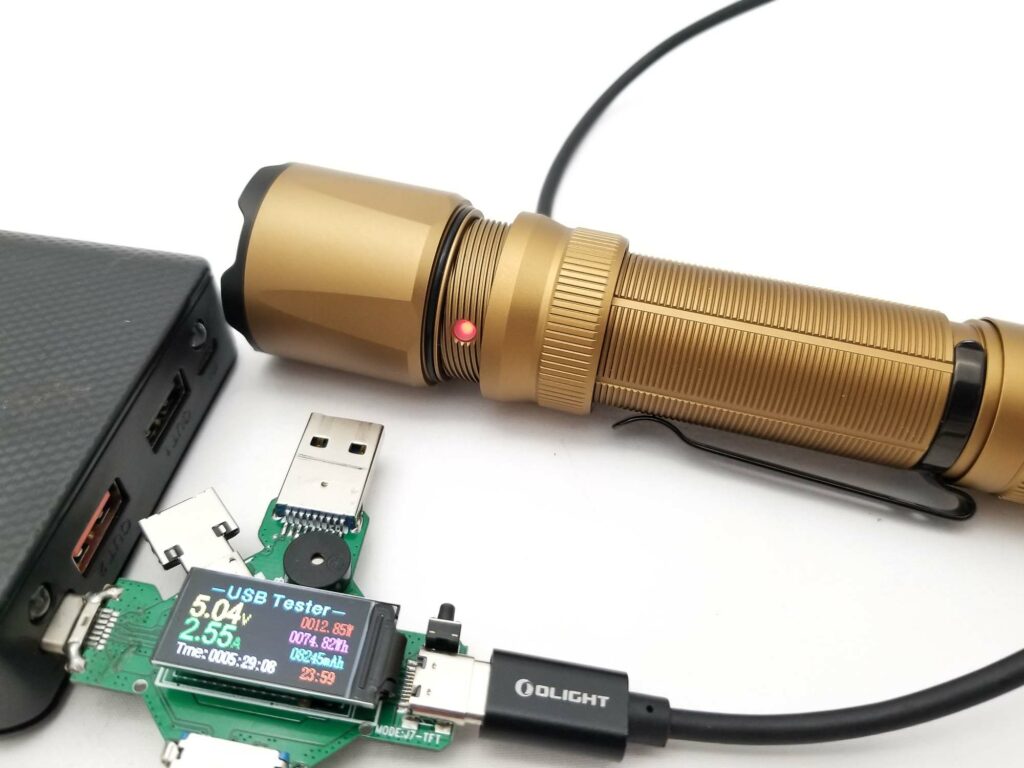
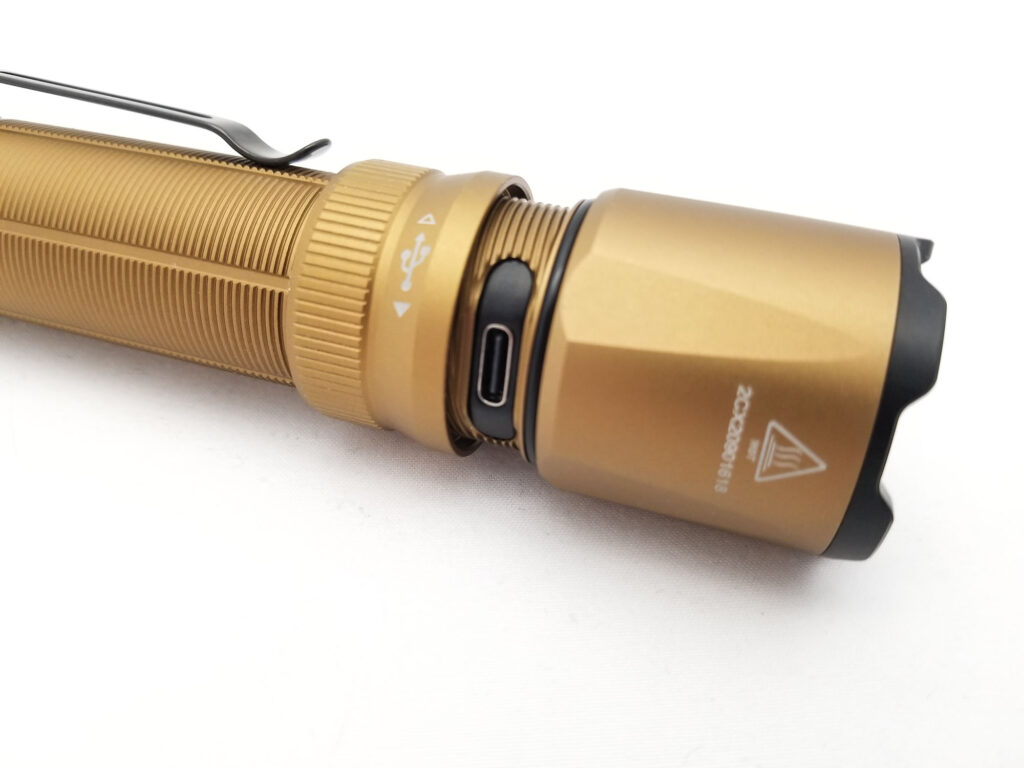
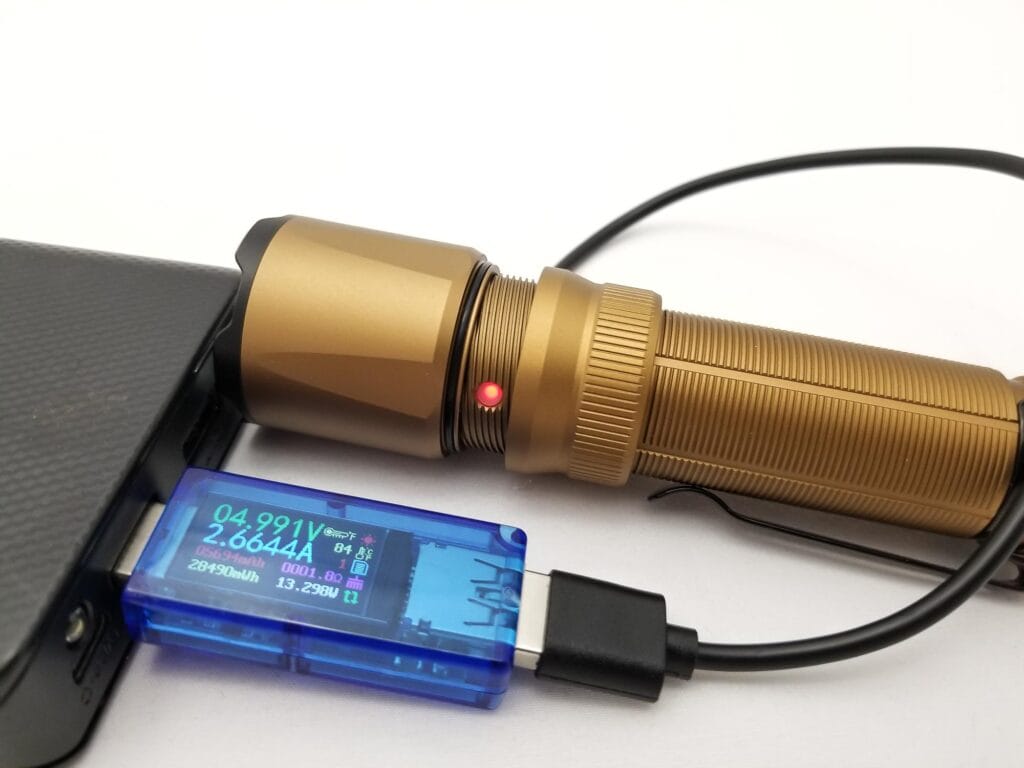
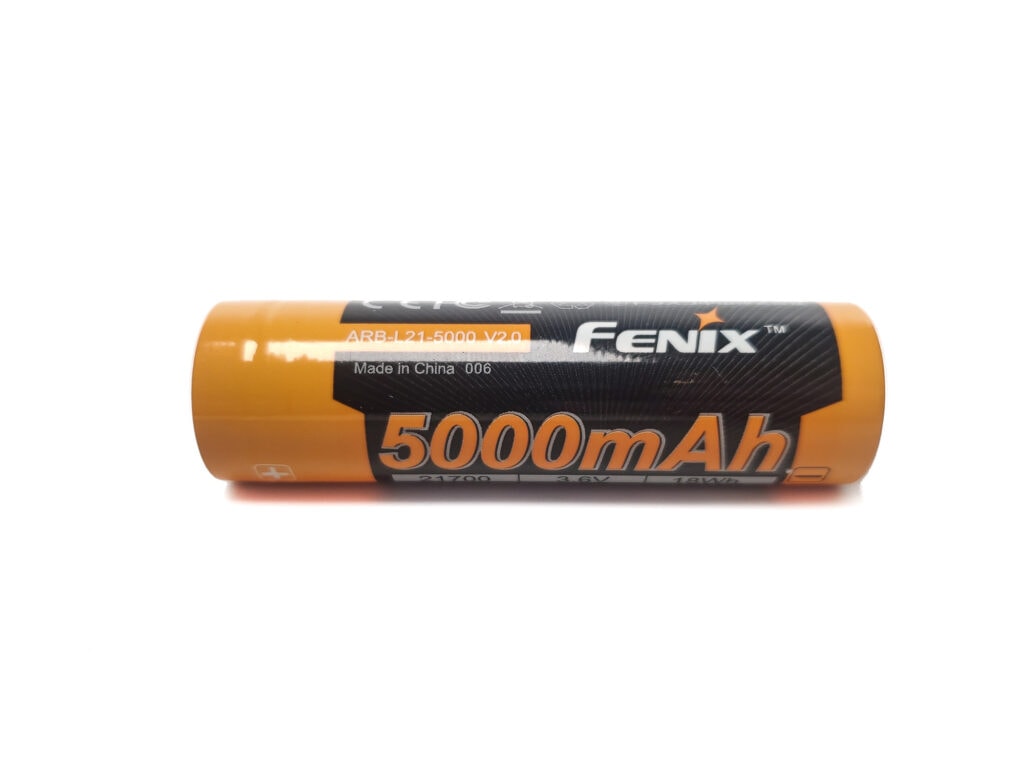
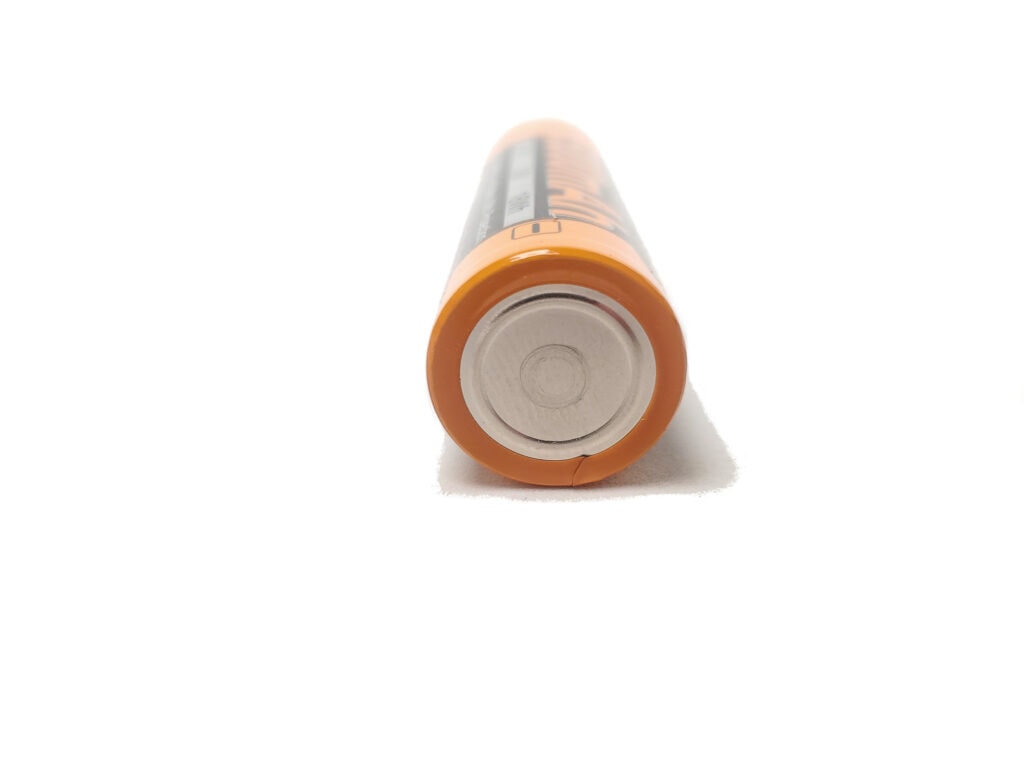
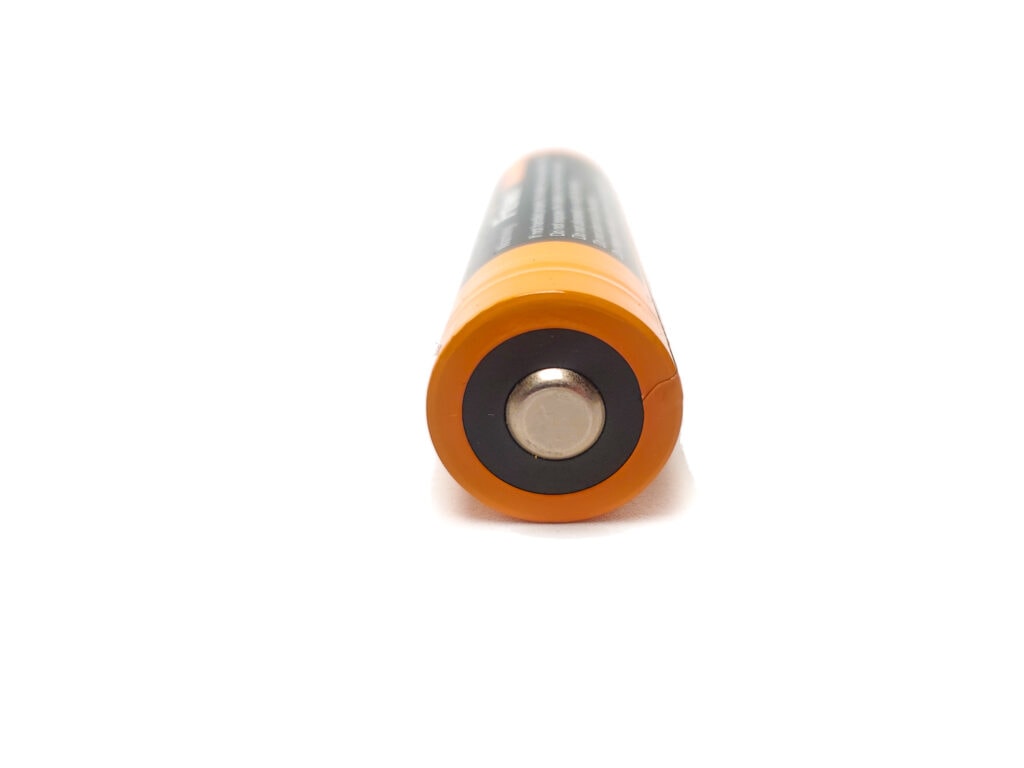
Performance test
Lumen measurements
How Lumens are Measured: Understanding ANSI FL1 Standards How Lumens are Measured: Understanding ANSI FL1 Standards: The ANSI FL1 standards specify that output in lumens should be measured 30 seconds after turning on, as this is the standardized time for measuring brightness according to the industry standard. This is why we focus on this part in our measurements. The ANSI FL1 standards require an ambient temperature of 22 ± 3°C. We record the ambient the ambient temperature to identify potential reasons for any observed discrepancies.Lumens are measured in my 50 cm integrating sphere with a Digi-Sense 20250-00 data logging luxmeter. The sphere has been calibrated with a Convoy S2+ measured to 260 Lumens and the figures are within 10% of actual. No current readings this time since the current path is weird due to the dual switches. I used the fully charged Fenix ARB-L21-5000 V2 battery for the test.
| Mode | Specs | turn on | 30 sec | 10 minutes |
|---|---|---|---|---|
| Low | 30 | 31 lm | 31 lm | – |
| Medium | 350 | 325 lm | 323 lm | 321 lm |
| High | 1000 | 849 lm | 849 lm | 824 lm |
| Turbo | 2800 | 2571 lm | 2078 lm | 640 lm |
Parasitic drain:
- Not tested
This is typical of Fenix and about what I expect. Even though I’m not hitting the advertised specs, these figures are well within my 10% margin of error with output and about what I get with SST70 and SFT70 lights from Fenix. In fact, the TK and PD series lights perform pretty similarly with these 70 series Luminus LEDs (see the runtime comparison for more on that).
Fenix TK20R UE Battery Life: Runtime graphs
How Runtimes are Measured: Understanding ANSI FL1 Standards About ANSI FL1 runtime standards: The runtime is measured until the light drops to 10% of its initial output (30 seconds after turning on). This does not mean that the flashlight is not usable anymore. The last column shows how long the light actually works till it shuts off. If there is a + symbol, it means that the test was stopped at that particular point, but the light was actually still running. This happens on certain occasions, with certain drivers, firmware, or batteries.Runtimes are measured in my 50 cm integrating sphere with a Digi-Sense 20250-00 data logging luxmeter. The sphere has been calibrated with a Convoy S2+ measured to 260 Lumens and the figures are within 10% of actual. I measure temperature readings with my Digi-Sense 20250-92 data logging thermocouple. The thermocouple is affixed to the head with kapton tape, and I used the same 5 second sampling rate as the luxmeter. I used the included ARB-L21-5000 V2 battery for the test.
| Mode | Specified runtime | Measured runtime ANSI | Time till shut off |
|---|---|---|---|
| Medium | 9h | 6h 15m | 10h+ |
| High | 3h 15m | 3h 18m | 4h 26m |
| Turbo | 3h | 2h 42m | 2h 46m |
The Medium runtime was a bit off, but this isn’t too bad since the light keeps running and running after the last step down. There’s visual LVP flashes when the output drops very low, and while you can’t see it normally, under the charge cover, the LED indicator flashes red. The driver is of course a fully regulated boost driver, and the output is very stable and laminar.
Fenix says the ATR is set for 60 C, and my thermocouple is showing a bit less, which isn’t bad (probably needs to be re calibrated). There’s no drama with the ATR either, and it tracks with the output on High and Turbo.
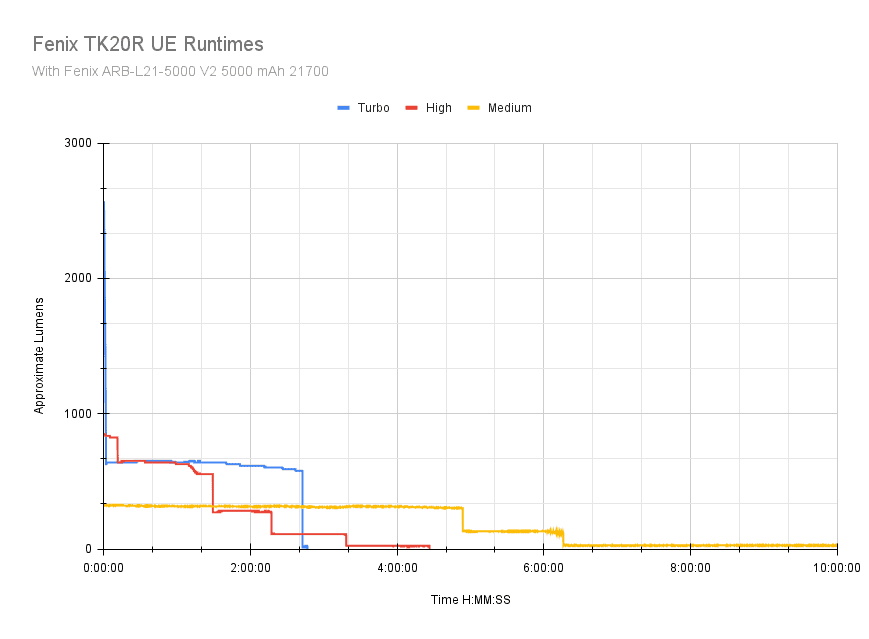
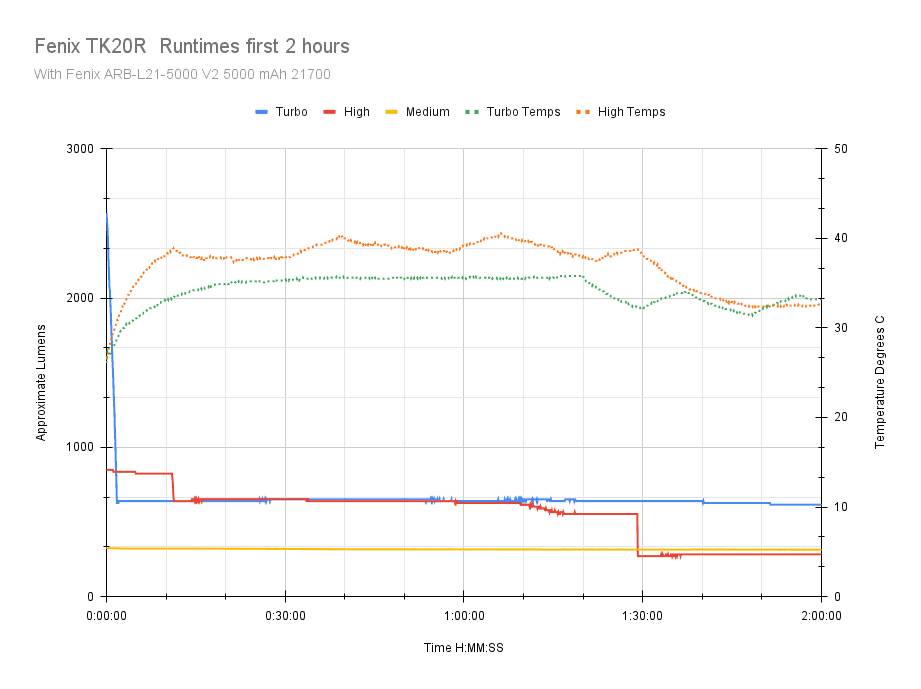
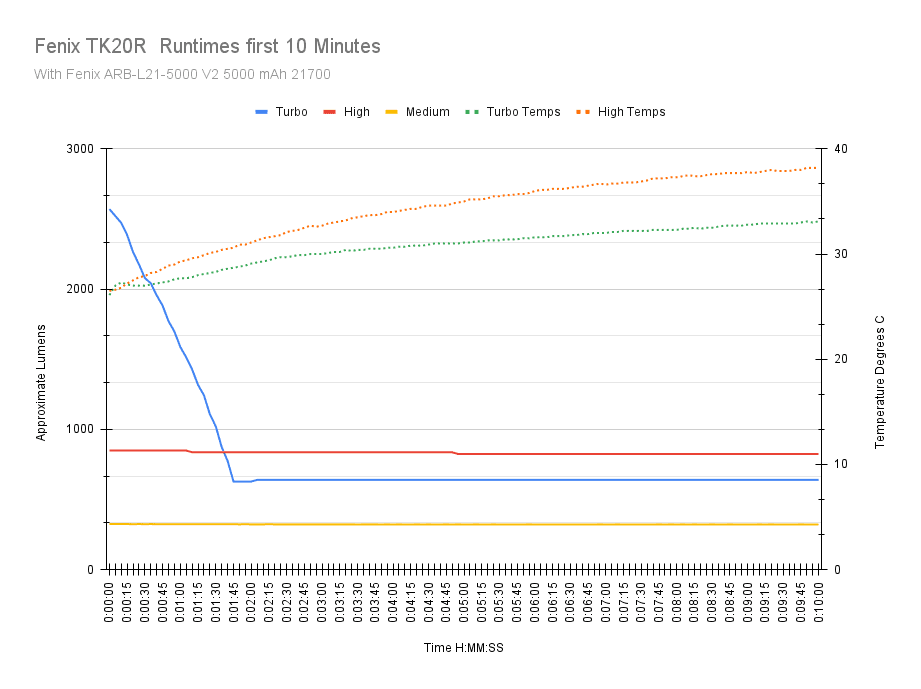
I threw in a Turbo runtime comparison graph of most of the best tactical-use and duty lights I’ve tested. I threw in the Acebeam P17 Defender, even though it has a bit of an unfair advantage in the XHP70.3 HI LED. These are all SST70 or SFT70 lights, and the mighty Klarus XT11 GT Pro V2, despite being an 18650 light outperforms the 21700 lights for output. It only takes a hit on runtime owing to the smaller capacity battery. Interestingly, the TK20R v2 performs better in my prior test than the TK20R UE. Maybe due to the battery? Still, very good performance.
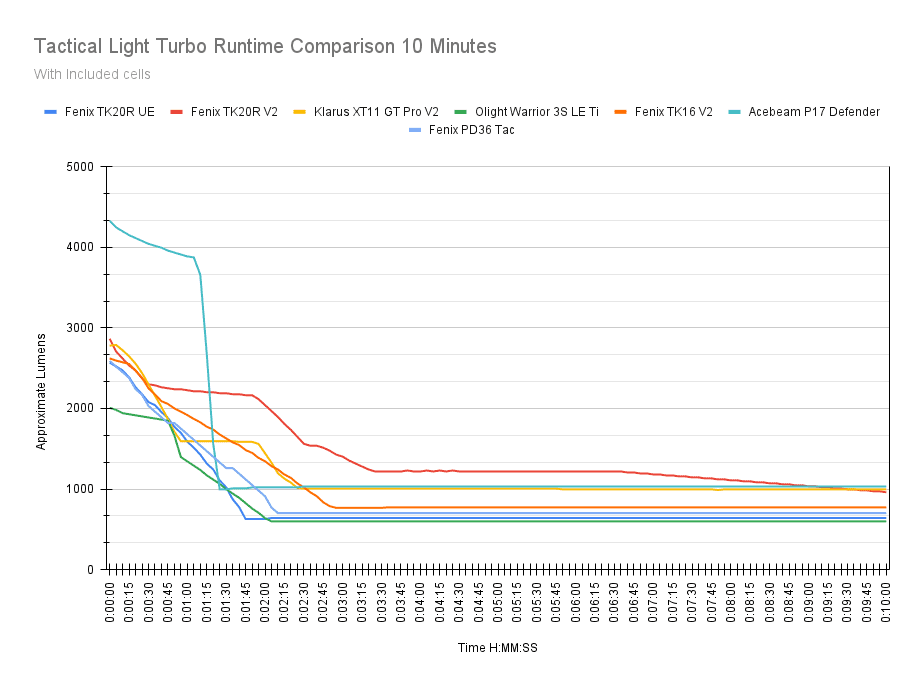
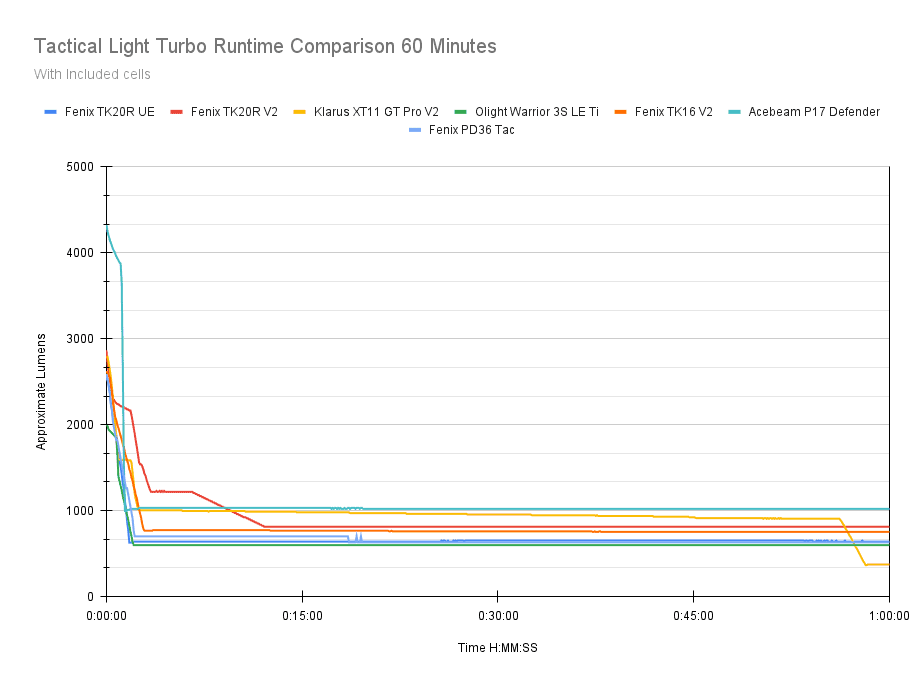
Peak beam intensity and beam distance measurements
About Peak beam intensity: Understanding ANSI FL1 Standards About peak beam intensity The calculated value of distance in meters at which the flashlight produces a light intensity of 0.25 lux. (0.25 lux is about the brightness of a full moon shining on an object). This means that the intensity has decreased so much, it becomes difficult to see darker objects, or objects that don’t reflect light. The columns ‘Meters’ and ‘Yards’ use rounded numbers.The beam distance test was conducted using the Uni-t UT383S luxmeter at a distance of 5 meters. I used the included ARB-L21-5000 V2 battery for the test. Measurements taken at 30 seconds per ANSI spec.
| Mode | Specs | Candela measured | Meters | Yards |
|---|---|---|---|---|
| Low | 490 cd | 575 | 48 | 52 |
| Medium | 5900 cd | 6675 | 163 | 178 |
| High | 17,880 cd | 17,875 | 267 | 292 |
| Turbo | 52,880 | 45,700 cd | 428 | 468 |
| Turbo at turn on | ? | 60,575 cd | 492 | 538 |
The throw figures look really good for this light, and again, about what I expected and similar to the TK20R v2. This is more than enough reach for any urban tactical use application.
Beamshots
Photos taken with my Samsung Note 8 set to 0.3s ISO 200 and 5000K WB. The fence is 40 meters distant.
Beamshots of the following flashlights compared:
- Fenix TK20R UE
- Fenix TK20R v2
- Fenix TK16 v2
- Fenix PD40R v2
- Fenix PD35 v3
- Fenix PD36 Tac
- Acebeam P17 Defender
- Olight Warrior 3S Special Edition (copper)
- Klarus XT11GT Pro v2



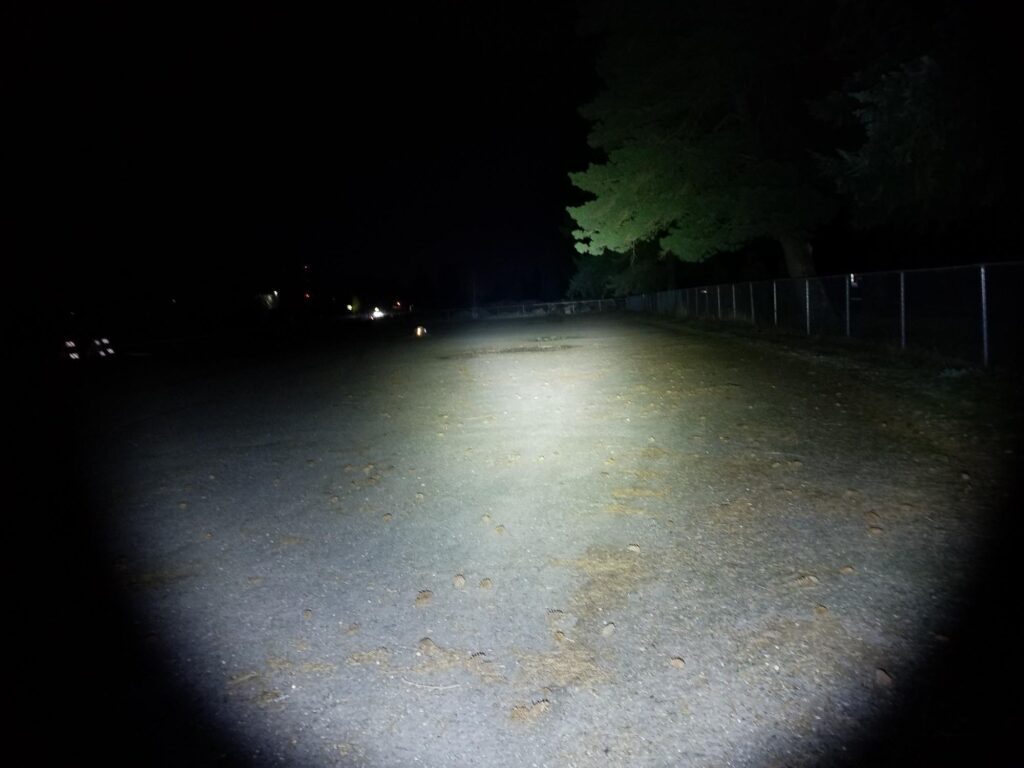





Disclaimer: This flashlight was sent to me for review at no cost by Fenix Lighting. I have not been paid to review, nor have I been holding back on problems or defects.
Final Verdict
Pros
- Awesome build quality, fit and finish
- Flexisensa selector switch works!
- Great output and decent throw
- Upgraded onboard charging
- Fully regulated output
- Complete kit including battery
Cons
- A bit down from advertised specs
- Charge port covers the battery status indicator when closed
Explanation on star ratings:
1: Avoid: a match would be a better choice – 2: Poor: significant defect or issues; almost unusable – 3: Average: some defects or issues; but still usable 4: Good: recommended (minor issues) – 5: Great: highly recommended

4.5 stars: ★★★★★⋆
While our star rating provides a reliable indicator, we encourage you to read the full review to make an informed decision based on your own needs and preferences.
Once again we see why Fenix has arisen to the upper echelon of the flashlight hierarchy. They took the already good TK20R v2 and made it better without resorting to gimmicky or superfluous features. There’s a lot I like about this TK20R UE: Fully regulated output, great beam distance, a tough, lightweight host, and a very unique and functional UI (the cool colors are nice too!). This would be a flashlight that appeals to consumers and pros alike.
The handling is intuitive, the UI is simple to negotiate, and the performance is on point with the competition. I appreciate the increased charging current as well. While it didn’t meet the factory spec, and the charge port cover, well, covers the LED indicator, Fenix did give it visual LVP notifications. I think this is a great alternative to the TK22 Tac with the rotary mode selector.
The Flexisensa selector works great and seems easier to manipulate under stress. Bottom line? If you don’t need the 4000+ of the XHP70.x equipped duty lights like the Acebeam P17 Defender or Klarus XT21X, the TK20R UE is worth a look if you’re considering a high output, 21700 size duty flashlight that also moonlights as a nice general purpose light. 4.5 stars for the Fenix TK20R UE.
Buy your Fenix TK20R UE with a 10% discount coupon
Get 10% off every purchase at Fenix Lighting US, by using our exclusive 1lumen discount code: 1lumen10
1lumen selects and reviews products personally. We may earn affiliate commissions through our links, which help support our testing.